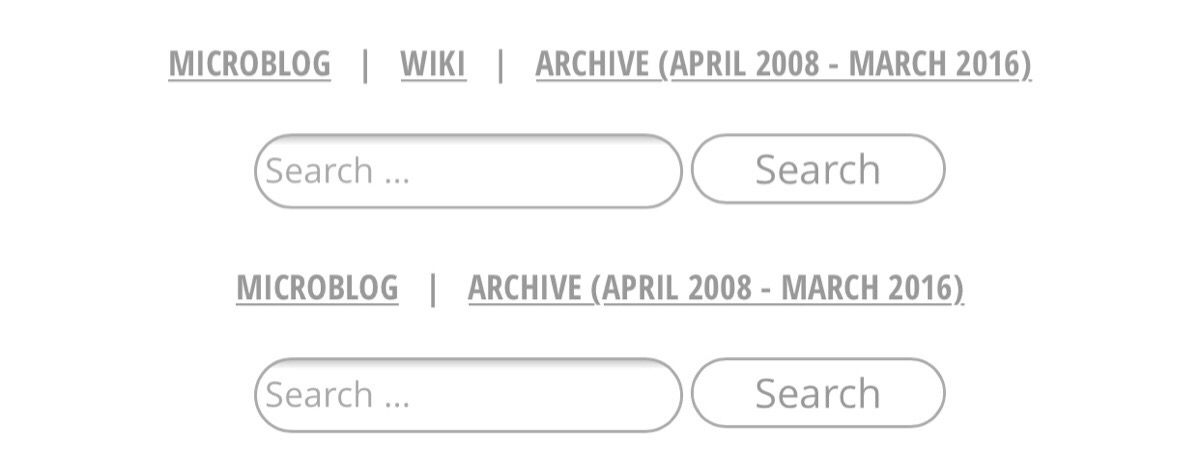# The initial invites for Micro.blog have been pushed back a few weeks but better to get it right than rush it. Also gives me more time to get the wiki straight.
Slow writing

I was inspired after being pointed to Mike Caulfield's speech "The Garden and the Stream" and his subsequent work on Wikity and wondered about some kind of self contained wiki-esque setup alongside the blog for research purposes.
He refers to his data collection, linking and iteration process as "slow writing" where ideas build over time using ongoing research to update topics.
I make notes but they are not organised, isolated scraps of information that may have sparked an idea but get lost.
I have tried Spark Files and lists, various methods but the result is invariably the same: the ideas get lost and my enthusiasm for them disappears.
I'm a fast writer.
If I can't get something out in one go that's usually it. Gone. Done. On to the next.
The recent exception being the Zuckerberg manifesto piece which I managed to keep working on for three days! I think the importance of the topic forced me to stay interested.
This is why self-hosted microblogging has been so enticing. It goes beyond the social networked element as it enables me to publish small thoughts that don't require deep dives and long processes but still makes me feel like I'm posting regularly, even if it doesn't appear in my main feed.
To my knowledge no one is currently reading these little missives but that's not actually the point right now.
Notes and research
So, I realise I need a system whereby I can make notes or store research items and they don't get lost. They need to be connected so that I can follow the paths between them and, most importantly, I can create them quickly on my phone.
I have considered wiki plugins for WordPress before but was never sure what I would do with them. A quick search, however, revealed Yada Wiki which creates a custom post type and allows for reasonably easy linking between entries via built in shortcodes.
One box ticked.
After installing it I realised that it exposes the custom post type via Workflow making for simpler posting from mobile.
We could be on to something.
Setting it up
A stream flows by whereas a garden grows around us, blooms. Caulfield explains how a garden allows for unique paths to be walked each time we visit and that there is no one true way to view it.
It is this thought, and its application to information, that influenced me to pursue this project. In doing so I set a few goals and technical objectives.
I wanted to keep it self contained and primarily for my own use. While everything will effectively be publicly accessible (it's just a case of knowing the addresses) I don't want it to be obviously available.
To achieve this I had to ensure a few things were configured:
- the link to the wiki will only show if logged in as admin - so that's only going to be me - using a quick role check:
if ( current_user_can('administrator') )

- the main site search had to be restricted to just posts so wiki items did not appear while searching from a wiki page would only query the wiki. Rather than calling the default
get_search_form()I needed to manually add the form code adding an extra input to determine the search scope:
or
- The right version of the search form needs to be called based on where you are on the site and we must consider that the search results page takes you out of context. The above inputs add additional parameters to the URL so it is an easy check:
I duplicated and modified my previous posting Workflow for use with the wiki, opening the entry for further editing such as adding tags and cross-links.
Unfortunately, the custom categories and tags created by the plugin are not available to Workflow so additional manual work is required to complete each entry.
Perhaps this isn't entirely a bad thing.
Ready to go
I feel like I've set up the basis of a very simple but usable framework for logging, keeping and cross referencing information that I may practice slow writing.
I haven't finalised exactly how it will look and how I will use it; I think it will need a reasonable amount of data before this becomes apparent.
I will allow myself to be guided rather than try to impose a potentially limiting process.
Comments
# So, a wiki solution is in place and can be posted to via Workflow. Decisions need to made on appearance etc. once data is in. Evolving.

Over the past couple of weeks I have been thinking about how to move forward with the blog or, rather, with writing in general after the Great Notes Catastrophy. The way the blog operates has changed over time but there's more that can be done to make it more individual, more personal. With that in mind I've been reading about digital gardens again. If you've been reading for a while you may remember that I tried this before, using a wiki plugin but it didn't work out at the time. I've said so many times about being a fast writer but feel that I'm finally ready to slow down. Updating my notes over a period of time (even if it was just to convince myself I was still interested) showed me that I could return, adding new thoughts without the pressure of having to finish or hit publish. I didn't want to do something as intense as a wiki (I installed Obsidian on my MacBook a while back but just haven't touched it) but wanted to do something more permanent than a blog post whilst still being just as casual. I don't think a notes app on my phone is really the ideal place for this so wondered about something on the blog; it would have to be simple enough to manage in a mobile browser. What if I took the inline editing from the blog and applied it to pages? Over the past couple of days I've, therefore, come up with a rudimentary solution which includes the following features:
new page templates for the "garden" the ability to create and delete pages programatically the same inline editing as with posts wiki style links between pages using "[[ ]]" delimiters that are automatically translated to working HTML tags on display. a parent/child system (so far only one layer deep) to group pages correctly
Home/Index:
Page:
As with the Post functionality, all controls are hidden if you don't have permission to use them. I plan to increase the number of child layers once I work out the logic for multiple nested queries but this will do for a start. I'm really happy with how it's come together in such a short space of time and hope that I'll make use of this more as it's a "roll your own" solution. I imagine it being the staging area for thoughts that could become posts as well as a resource to link to from elsewhere.